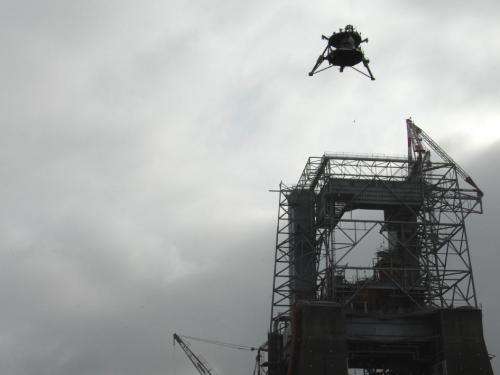'Mighty Eagle' lander aces major exam

(Phys.org)—Completing this round of flight test objectives, the "Mighty Eagle," a NASA robotic prototype lander, flew to an altitude of 100 feet and descended gently to a controlled landing during a successful free flight Sept. 5 at NASA's Marshall Space Flight Center in Huntsville, Ala.
Guided by autonomous rendezvous and capture software, the vehicle located an on-the-ground target using its onboard camera and flew to it. Last week's flight followed a preprogrammed flight profile, but today's operated "closed loop," with the vehicle seeking and finding its target using the onboard software to guide the flight.
"The 'Mighty Eagle' had a great flight, fulfilling the objectives we had for this test—finding and landing on its target using a closed-loop system," said Greg Chavers, test lead for the project. "Given this is one of our last tests in this series, it is a worthy finale of a lot of people's hard work—including our young engineers. They did a remarkable job running today's flight."
New for this test, the "Mighty Eagle" project managers turned over the vehicle's keys to three young Marshall engineers, Adam Lacock, flight manager; Jake Parton, test conductor; and Logan Kennedy, systems engineer.
Nicknamed the "Mighty Eagle" after one of the characters in the popular "Angry Birds" game, the vehicle is a three-legged prototype that resembles an actual flight lander design. It is 4 feet tall and 8 feet in diameter and, when fueled, weighs 700 pounds. It is a "green" vehicle, fueled by 90 percent pure hydrogen peroxide, and is guided by an onboard computer that activates the thrusters to power the craft's movements.
"We've surpassed our expectations and flew the most challenging run to date," said Mike Hannan, a controls engineer in Marshall's Engineering Directorate. "It was an overcast, extremely humid day, and we were concerned steam might block the vehicle's camera. We didn't see that, and the lander sought and found its target successfully."
"It was an invaluable experience managing today's test," added Lacock. "This is the kind of experience young engineers, like myself, need to learn more about flight mechanics, vehicle hardware and project management. It was a good day for our team."
NASA will use the "Mighty Eagle" to mature the technology needed to develop a new generation of small, smart, versatile robotic landers capable of achieving scientific and exploration goals on the surface of the moon, asteroids or other airless bodies.
Provided by NASA


















